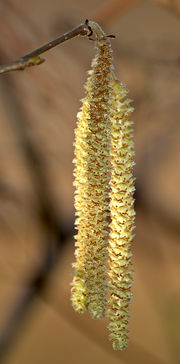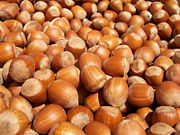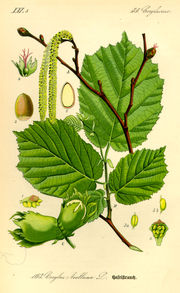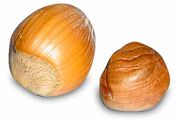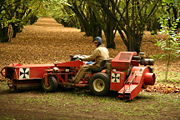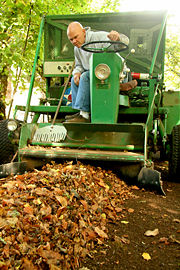Corylus avellana
2008/9 Schools Wikipedia Selection. Related subjects: Plants
| Common Hazel | ||||||||||||||
|---|---|---|---|---|---|---|---|---|---|---|---|---|---|---|
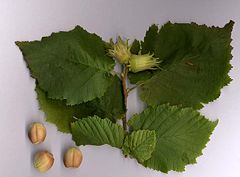 Common Hazel leaves and nuts
|
||||||||||||||
| Conservation status | ||||||||||||||
|
Secure
|
||||||||||||||
| Scientific classification | ||||||||||||||
|
||||||||||||||
| Binomial name | ||||||||||||||
| Corylus avellana L. |
The Common Hazel (Corylus avellana) is a species of hazel native to Europe and western Asia, from the British Isles south to Iberia, Greece, Turkey and Cyprus, north to central Scandinavia, and east to the central Ural Mountains, the Caucasus, and northwestern Iran.
Botany
Common hazel is typically a shrub reaching 3-8 m tall, but can reach 15 m. The leaves are deciduous, rounded, 6-12 cm long and across, softly hairy on both surfaces, and with a double-serrate margin. The flowers are produced very early in spring, before the leaves, and are monoecious with single-sex wind-pollinated catkins. Male catkins are pale yellow and 5-12 cm long, while female catkins are very small and largely concealed in the buds with only the bright red 1-3 mm long styles visible. The fruit is a nut, produced in clusters of one to five together, each nut held in a short leafy involucre ('husk') which encloses about three quarters of the nut. The nut is roughly spherical to oval, 15-20 mm long and 12-20 mm broad (larger, up to 25 mm long, in some cultivated selections), yellow-brown with a pale scar at the base. The nut falls out of the involucre when ripe, about 7-8 months after pollination.
It is readily distinguished from the closely related Filbert (Corylus maxima) by the short involucre; in the Filbert the nut is fully enclosed by a beak-like involucre longer than the nut.
Common hazel is used by a number of species of Lepidoptera as a food plant.
The scientific name avellana derives from the town of Avella in Italy, and was selected by Linnaeus from Leonhart Fuchs's De historia stirpium commentarii insignes (1542), where the species was described as "Avellana nux sylvestris" ("wild nut of Avella").
Cultivation and uses
The Common Hazel is an important component of the hedgerows that were the traditional field boundaries in lowland England. The wood was traditionally grown as coppice, the poles cut being used for wattle-and-daub building and agricultural fencing.
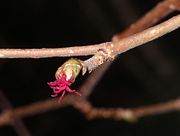
| Hazelnuts (edible parts) Nutritional value per 100 g (3.5 oz) |
||||||||||||||||||||||||||||
|---|---|---|---|---|---|---|---|---|---|---|---|---|---|---|---|---|---|---|---|---|---|---|---|---|---|---|---|---|
| Energy 630 kcal 2630 kJ | ||||||||||||||||||||||||||||
|
||||||||||||||||||||||||||||
| Percentages are relative to US recommendations for adults. Source: USDA Nutrient database |
||||||||||||||||||||||||||||
Hazelnuts are rich in protein and unsaturated fat. Moreover, they contain significant amounts of thiamine and vitamin B6, as well as smaller amounts of other B vitamins. Additionally, for those persons who need to restrict carbohydrates, 1 cup (237 ml) of hazelnut flour has 20 g of carbohydrates, 12 g fibre, for less than 10 net carbohydrates.
There are many cultivars of the Hazel, including 'Barcelona', 'Butler', 'Casina', 'Clark' 'Cosford', 'Daviana', 'Delle Langhe', 'England', 'Ennis', Fillbert, 'Halls Giant', 'Jemtegaard', 'Kent Cob', 'Lewis', 'Tokolyi', 'Tonda Gentile', 'Tonda di Giffoni', 'Tonda Romana', 'Wanliss Pride', and 'Willamette'. Some of these are grown for specific qualities of the nut including large nut size, and early and late fruiting cultivars, whereas other are grown as pollinators. The majority of commercial Hazelnuts are propagated from root sprouts. Some cultivars are of hybrid origin between Common Hazel and Filbert.
Common Hazel is cultivated for its nuts in commercial orchards in Europe, Turkey, Iran and Caucasus. The name "hazelnut" applies to the nuts of any of the species of the genus Corylus. This hazelnut or cobnut, the kernel of the seed, is edible and used raw or roasted, or ground into a paste. The seed has a thin, dark brown skin which has a bitter flavour and is sometimes removed before cooking. The top producer of hazelnuts, by a large margin, is Turkey, specifically the Ordu Province. Turkish hazelnut production of 625,000 tonnes accounts for approximately 75% of worldwide production.
In the United States, hazelnut production is concentrated in two states, Oregon and Washington; however, they are also grown extensively just to the north, in the Fraser Valley of British Columbia, Canada. In 1996 the in-shell production in Oregon was about 19,900 tons (18,000 tonnes) compared to 100 tons (91 tonnes) in Washington (. Recent orchard plantings in California are likely to increase production in the USA. The hazelnut is also growing in popularity in the USA with a Hazelnut Council set up to promote its use. The harvesting of hazelnuts is either by hand in rural communities, or by manual or mechanical raking of fallen nuts.
Hazelnuts are extensively used in confectionery to make praline and also used in combination with chocolate for chocolate truffles and products such as Nutella. In the USA, hazelnut butter is being promoted as a more nutritious spread than its peanut butter counterpart, though it has a higher fat content. In Austria and especially in Vienna hazelnut paste is an important ingredient in the world famous torts (such as Viennese hazelnut tort) which are made there. Vodka-based Hazelnut liqueurs, such as Frangelico, are also increasing in popularity, especially in the U.S. and eastern Europe.
Hazelnut is popular as a coffee flavouring, especially in the form of Hazelnut latte. Hazelnut-flavoured coffee seems (to many users) to be slightly sweetened and less acidic, even though the nut is low in natural saccharides. The reason for such perception is not yet understood.
In Australia over 2000 tonnes are imported annually mostly to supply the demand from the Cadbury company for inclusion in its eponymous milk chocolate bar which is the third most popular brand in Australia. Hazelnut oil, pressed from hazelnuts, is strongly flavoured and used as a cooking oil. Hazelnuts are also grown extensively in Australia in orchards growing varieties mostly imported from Europe.
Primitive archers have also used the wood of the hazelnut in the making of arrows. The fine grain and tendency to grow with fairly straight shoots makes them suitable shaft material.
Harvesting
Hazel nuts are harvested annually in mid autumn. As autumn comes to a close, the trees drop their nuts and leaves. Most commercial growers wait for the nuts to drop on their own, rather than use equipment to shake them from the tree.
There are three primary pieces of equipment used in commercial harvesting; the sweeper, the harvester, and the forklift. The sweeper centralises the material into rows, the harvester lifts and separates the nuts from the debris, and the forklift hauls the nuts away for processing. The sweeper is a low-to-the-ground tractor that makes multiple passes up and down the rows with a 2 m belt attached to the front that sweeps leaves, nuts, and small twigs from left to right, depositing the material in a row as it drives forward. On the rear of the tractor is a powerful blower that pushes material left into the adjacent row with air speeds up to 90 m/s. Careful grooming during the year and patient blowing at harvest can eliminate the need for hand raking around the trunk of the tree where nuts can accumulate. The sweeper will prepare two rows at a time as it goes up and down the rows. After its final pass, all the material on the ground has been deposited in 60 cm wide rows for the harvester to process. It is best to only sweep a few rows ahead of the harvesters at any given time, as the rows are susceptible to moisture and parasites over time.
The harvester is a slow moving machine that lifts the material off the ground and separates the nuts from the leaves, empty husks, and small twigs. As the harvester drives over the rows, a fast spinning cylinder with hundreds of tines rakes the material onto a belt. The belt takes the material over a blower and under a powerful vacuum that sucks the light weight dirt and leaves off the nuts and discharges it into the orchard. The remaining nuts are conveyed into a tote box.
Once a box fills with nuts, a third tractor will haul away full boxes and bring empties to the harvester to minimise time spent not collecting nuts.
There are two different timing strategies for collecting the fallen nuts. The first option is to harvest early when only half of the nuts have fallen. With less material on the ground, the machines can work much faster and are less subject to breakdown. The other option is to wait for all the nuts to fall and go over the crop once. The first option is easier, but takes longer to perform with two passes.
Ideally, the orchard should not be so dry that an abundance of dust can reduce vision and equipment efficiency. Conversely if it is too wet, mud cakes in the machinery and moisture weighs down the material, making it more difficult to lift and separate.
Diseases
Mesolithic Food Industry
In 1995 evidence of large-scale Mesolithic nut processing, some 9,000 years old, was found in a midden pit on the island of Colonsay in Scotland. The evidence consists of a large, shallow pit full of the remains of hundreds of thousands of burned hazelnut shells. Hazelnuts have been found on other Mesolithic sites, but rarely in such quantities or concentrated in one pit. The nuts were radiocarbon dated to 7720+/-110BP, which calibrates to circa 7000 BC. Similar sites in Britain are known only at Farnham in Surrey and Cass ny Hawin on the Isle of Man.
This discovery gives an insight into communal activity and forward planning in the period. The nuts were harvested in a single year and pollen analysis suggests that the hazel trees were all cut down at the same time. The scale of the activity, unparalleled elsewhere in Scotland, and the lack of large game on the island, suggests the possibility that Colonsay contained a community with a largely vegetarian diet for the time they spent on the island. The pit was originally on a beach close to the shore, and was associated with two smaller stone-lined pits, whose function remains obscure, a hearth, and a second cluster of pits.
